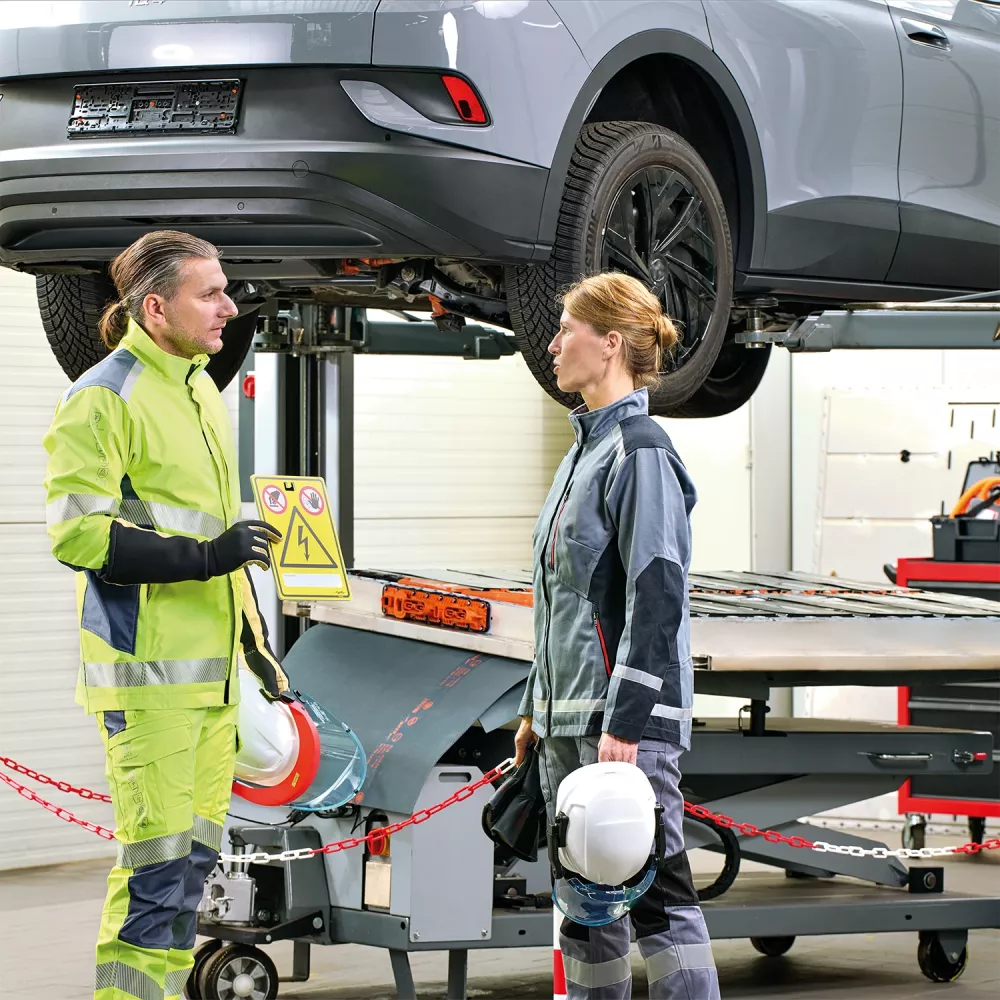Check list for working safely on electric vehicles
Certain safety standards are required for working on electric vehicles and must be adhered to. The information provided by the DGUV (German Social Accident Insurance association) provides an overview of the relevant requirements. To ensure that all employees have the necessary knowledge and qualifications for working on vehicles with high-voltage systems, our experts have designed a check list for you in accordance with DGUV-I 209-093.

Occupational safety in e-mobility in accordance with DGUV-I 209-093
When it comes to working safely with high-voltage systems, a thorough risk assessment for electric vehicles is essential in order to identify potential risks and take appropriate protective measures. DGUV-I 209-093 plays an important role in this context, as it describes the qualifications and measures for the safe handling of HV vehicles.
Our check list supports you step by step in protecting yourself and your employees and complying with the legally prescribed standards.
Do you know the legal order of priority of specifications concerning protection when
working on an electric vehicle?
- The German Occupational Health and Safety Act?
- The German Ordinance on Industrial Safety and Health?
- The DGUV regulations or information, standards (e.g. DGUV-I 203-077 Thermal hazards due to electric arcs, DGUV-I 209-093 Qualification for work on vehicles with high-voltage systems)?
Are the responsibilities for the work processes regulated?
- Has a responsible person been appointed for the HV area?
Is a risk assessment carried out regularly and documented according to the state of the art (e.g. specification of the vehicle manufacturer according to the work order)?
- Is all work equipment fit for purpose (e.g. PPE, tools)?
- The working environment must be taken into account (ability to cordon off a workplace, precautions against unauthorised access, escape and rescue routes)
- Hazards on the work object (e.g. electric vehicle, battery) must be avoided by following the manufacturer's instructions.
- Check the physical and mental strain on employees, especially when using work equipment (e.g. what should they wear in hot weather?)
- Boost employees' personal responsibility (I'm not feeling well = not working)
- Allow for operational malfunctions (oil spill, water damage)
Is the designated work area properly equipped?
- Is there a rescue rod?
- Warning and information signs?
- Barrier chains?
- Is there a clearly defined HV range?
Is the assignment standardised and predefined?
If not, it must be defined according to the vehicle manufacturer's specifications. The same applies to components to be repaired or replaced.
Also think about the future
Will there be enough equipped workstations available in the future?
Warning and cordoning off – are the work areas secure?
Are the work areas secured against access by unauthorised persons by means of warning signs and barriers?
Are specialists available?
Are the following qualified employees available in accordance with the specified work procedure?
- Electrically instructed person
- Person with extensive training in high voltage
- HV expert
- Is the work equipment and protective equipment available for the specified work order?
- Have the work equipment and protective equipment been checked for externally visible damage and defects and for proper functioning before use?
- If insulating protective clothing is used, has it been checked for compliance with the limit values specified in the electrotechnical regulations in accordance with the test intervals? For insulating protective clothing e.g. every 12 months, for insulating gloves > 1,000 V every 6 months.
Are the following points checked before the PPE is used?
- Clothing fits properly (size)
- Correct protection class
- Visual inspection (e.g. sealing system, cleanliness, tears, seams)
Are employees deployed correctly according to their qualification level?
- S: Operation of vehicles
- 1S: Non-electronic activities on vehicles
- 2S: Electrotechnical activities with prior voltage disconnection
- 3S: Electrotechnical activities on non-intrinsically safe vehicles or live
working on the vehicle or on HV components
Has it been ensured that no external interferences distract from the work process?
Are emergency measures defined for an accident in the HV area?
- Rescue rod
- Rescue chain
- Rescue routes
- Procedural instructions
- First-aiders
- Emergency measures
Relevant standards for work safety in electric mobility
- DGUV-I 209-093 of the German Social Accident Insurance association contains the necessary qualifications for working on vehicles with high-voltage systems.
- DGUV-I 203-077 defines the thermal hazards caused by arc faults.
- The standard EN 50110-1 regulates the operation of electrical installations.
What other topics are of interest to you?
Just select them and read on.
